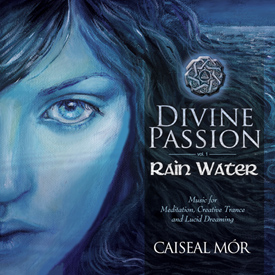Caiseal Mór, an Australian fantasy author with twelve novels (and counting) to his credit, is also a composer and musician who is currently working on a series of trance albums, of which Divine Passion is the first. It bills itself as “music for meditation, creative trance and lucid dreaming.”
 The music does have a hypnotic quality to it. The first track, “Nomad,” is, as others have described Mór’s music, “cinematic” — strongly evocative, almost imagistic, a slow, majestic theme played on what sounds like low strings. I say “sounds like” because this music was assembled on a computer, and I have not discovered any credit for “strings,” although Mór seems to have done most everything else on this album himself — except the vocals by Swa Ashar. “Nomad” is something of a stand-alone piece, but also an introduction and prequel to “Rain Water.”
The music does have a hypnotic quality to it. The first track, “Nomad,” is, as others have described Mór’s music, “cinematic” — strongly evocative, almost imagistic, a slow, majestic theme played on what sounds like low strings. I say “sounds like” because this music was assembled on a computer, and I have not discovered any credit for “strings,” although Mór seems to have done most everything else on this album himself — except the vocals by Swa Ashar. “Nomad” is something of a stand-alone piece, but also an introduction and prequel to “Rain Water.”
“Rainwater” as music is quite seductive, and displays a panoply of influences ranging from Western art music through rhythms and colors from the pan-Islamic complex to elements derived from Aboriginal and American Indian sources. The themes from “Nomad” appear and reappear, tying the CD together quite effectively. As an old hand at the new age genre, I’m willing to count this as one of the better efforts. (I should also note that, in spite of sharing some characteristics, “Rain Water” is a far cry from the club trance of the 1990s — which I also happen to like a lot.)
This is, however, music with a purpose. These pieces were designed, according to Mór, to assist in what he calls “creative trance,” in which the mind is not passively experiencing a trance state, but is actively engaged in a creative process of imagining. Mór likens it to the state he’s when writing or composing; I suspect it’s similar to what I experience in the darkroom, which is simply decision-making by nonverbal pathways. The package here does include an eight-page booklet discussing how to use the music for that purpose — or you can just kick back and enjoy it.
 Beautiful Hands, on which Mór is joined by Helen Wells, Paul Jarman, Kim Sanders, Helen Rivero and Peter Kennard, is a slightly different story. Subtitled “Music of the Celtic Harp,” it’s a collection of songs composed by Mór, featuring the harp but also making forays into other traditions and other sounds. “The Faerie Queen,” for example, could indeed be an Irish ballad. “Woman at the Well,” on the other hand, carried mainly by flute and guitar, owes a great deal to the music of Spain. “Imramma” pulls us back to an early tradition that could be Celtic, Iberian, or Baltic — I’m sure I caught a bit of the wistful sound of the American cedar flute in there, as well.
Beautiful Hands, on which Mór is joined by Helen Wells, Paul Jarman, Kim Sanders, Helen Rivero and Peter Kennard, is a slightly different story. Subtitled “Music of the Celtic Harp,” it’s a collection of songs composed by Mór, featuring the harp but also making forays into other traditions and other sounds. “The Faerie Queen,” for example, could indeed be an Irish ballad. “Woman at the Well,” on the other hand, carried mainly by flute and guitar, owes a great deal to the music of Spain. “Imramma” pulls us back to an early tradition that could be Celtic, Iberian, or Baltic — I’m sure I caught a bit of the wistful sound of the American cedar flute in there, as well.
The enchantment here is of a different order, although one can, without too much effort, see the commonalities with Divine Passion, if in no other way than that this is also music that very easily frees the imagination to roam, even though in this collection, I think that’s subtext rather than text..
Music does something in that realm that I don’t think any other medium can accomplish: it cuts effortlessly through our defenses on its way to a place unmediated by the linguistic structures we’ve developed to assign meanings. (The only other art form I come up with that can do that is dance, but that’s another essay.) That’s not always the intent, and there’s a lot to do with inherited cultural patterns in that, but I think the mere fact that an artist such as Mór (and he’s certainly not alone in this regard) can combine so many and such diverse influences to make music that is not only understandable but enjoyable points to something in music that bypasses those patterns easily and sometimes undetectably.
I mentioned commonalities between these two collections, and that’s really it: Mór has quite effectively used that “reach for the gut” quality of music to provide opportunities to do a little bit more than listen. The result is a pair of CDs, each with its own brand of charm, that can be what you want them to be.
(Blue Angel Gallery, 2007)
(Blue Angel Gallery, 2007)
